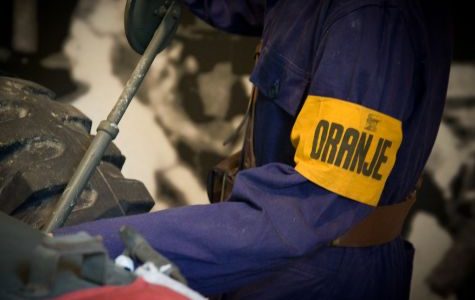Dutch resistance.

The Dutch resistance to the Nazi occupation of the Netherlands during World War II can be mainly characterized by its prominent non-violence, peaking at over 300.000 people in hiding in the autumn of 1944, tended to by some 60.000 to 200.000 illegal landlords and caretakers and tolerated knowingly by some one million people, including German occupiers and military.
Dutch resistance developed relatively slowly, but the event of the February strike and its cause, the random police harassment and deportation of over 400 Jews, greatly stimulated resistance. The first to organize themselves were the Dutch communists, who set up a cell-system immediately. Some other very amateurish groups also emerged, notably De Geuzen, set-up by Bernardus Ijzerdraat 
 and also some military-styled groups started, such as the Order Service. Most had great trouble surviving betrayal in the first two years of the war.
and also some military-styled groups started, such as the Order Service. Most had great trouble surviving betrayal in the first two years of the war.
 Bernardus Ijzerdraat was captured by the SD in Haarlem and after a show trial, he was shot at Scheveningen on 13 March 1941, age 49, together with 17 others, including three Communists involved in the February Strike. Another resistance victim was the girl with the red hair, teh famous and brave Hannie Schaft.
Bernardus Ijzerdraat was captured by the SD in Haarlem and after a show trial, he was shot at Scheveningen on 13 March 1941, age 49, together with 17 others, including three Communists involved in the February Strike. Another resistance victim was the girl with the red hair, teh famous and brave Hannie Schaft. 

Dutch counterintelligence, domestic sabotage, and communications networks eventually provided key support to Allied Forces, beginning in 1944 and continuing until the Netherlands was fully liberated. Some 75% (105.000 out of 140.000) of the Jewish population perished in the Holocaust, most of them murdered in Nazi death camps. A Jewish victim was the German girl Anne Frank, another the Dutch Sinti girl Settlana Steinbach. A number of resistance groups specialized in saving Jewish children, including the Utrechtse Kindercomité, the Landelijke Organisatie voor Hulp aan Onderduikers, the Naamloze Vennootschap (NV), and the Amsterdam Student Group. The Columbia Guide to the Holocaust estimates that 215-500 Dutch Romanis were killed by the Nazis, with the higher figure estimated as almost the entire pre-war population of Dutch Romanis.
The resistance brothers Leo and Martin Looymans, brothers of my godmother Annie Looymans in Budel, were beaten to death with the butts of their rifles, with four other by the SS, two days before the end of the war as they blew up the rails of an SS train  in their region.
in their region.













Leave a Reply